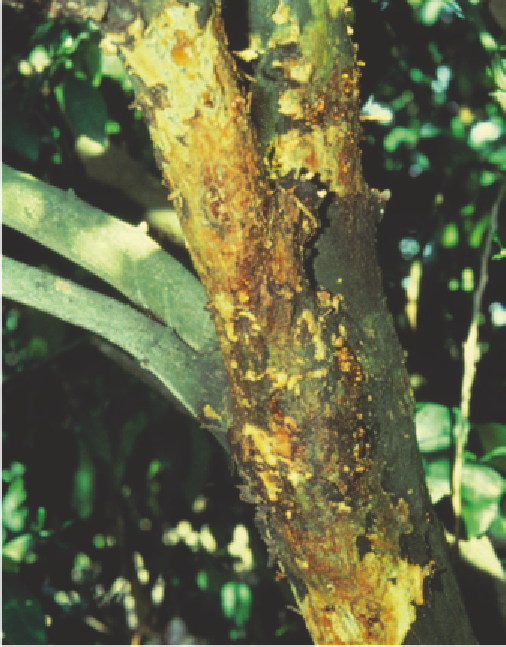Agriculture Reference
In-Depth Information
If susceptible rootstocks must be used and replant land
cannot be fallowed, treat the soil with recommended
registered nematicides.
adhering to roots. Resistance to
T. se mipe ne t ran s
is generally found in commercial varieties incorporating
trifoliate orange (e.g. Troyer citrange, Swingle citrumelo).
•
Good management practices, such as regular watering,
mulching/organic matter incorporation, balanced
nutrition and timely control of other pests and diseases,
reduce the stress on citrus trees and help reduce the
effects of citrus nematodes.
The ectoparasitic feeding of
Paratrichodorus
spp. on
root tips, even those of varieties considered resistant to
T. se mipe ne t ran s
, prevents root elongation causing roots to
have a stubby appearance, hence known as 'stubby root'.
•
Source of infection and spread
Nematodes pathogenic to citrus generally do not occur in
new citrus orchards, but are introduced into an orchard in
infested planting material or contaminated equipment.
However, the cropping history of a new orchard should be
considered, because hosts such as grapes and olives can be
associated with nematodes parasitic to citrus. Nematodes
can also be spread in soil carried by surface water or
machinery. Once soil and established trees are
contaminated with nematodes, young replant trees are
likely to be more seriously affected by high nematode
populations.
VIRUS AND VIRUS-LIKE
DISEASES
PSOROSIS
■
Cause
Citrus psorosis virus
(Ophiovirus).
Symptoms
Psorosis occurs in A and B forms, which are associated with
mild and severe strains of the virus, respectively. Psorosis A
is best characterised by scaling of bark in the trunk and
Importance
Nematodes are generally widespread and capable of
reducing growth and yield of citrus under suitable
conditions. The impact of nematodes will be determined
largely by rootstock, soil type, salinity and soil moisture.
Fine-textured and sandy soils are conducive of large
T. se mipe ne t ran s
populations, but most soil types can
support nematodes to some degree. In Australia, citrus
grafted to susceptible rootstocks planted on sandy soils
adjacent to the Murray River have been adversely affected
by nematodes.
Management
•
Use nematode-free planting material.
Avoid contaminating virgin soil by thorough hygiene
measures (e.g. decontaminating work boots and
equipment, pasteurising potting mix), and divert run-off
water from infested blocks.
•
Use resistant rootstocks (e.g. Swingle citrumelo, Troyer
citrange) in replant blocks or shallow soils (less than
750 mm deep).
•
Fallow replant soil for as long as possible before
replanting to help reduce the nematode populations
(although this will not eradicate them; e.g. a two-year
fallow will substantially reduce nematode numbers).
Planting nematode-resistant cover crops or biofumigant
crops, and cultivation or deep-ripping can improve the
effectiveness of fallow periods.
•
Fig 6.45 Psorosis symptoms on bark. Bark scaling and flaking occurs on
the trunk and limbs of sweet orange and grapefruit.












